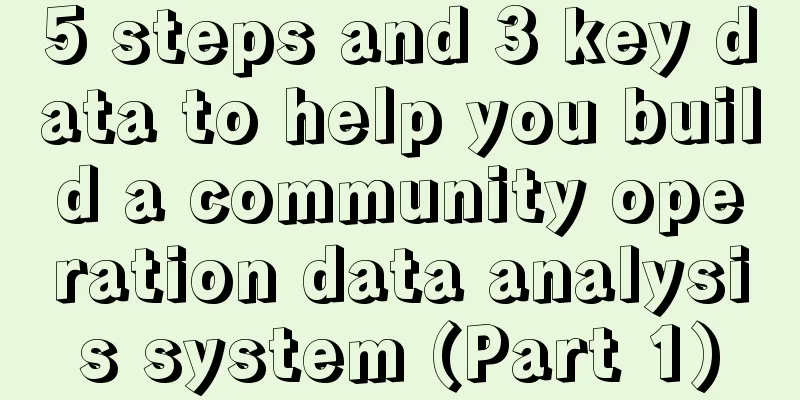5 steps and 3 key data to help you build a community operation data analysis system (Part 1)

The current business environment has begun to move from traffic operations to retention operations. In the stock era, the pursuit of digitalization can be said to be an inevitable trend. Therefore, the content of data analysis has been valued by more and more companies. When we operate a community, data analysis is also an essential basic skill. So, today we are going to talk about community operation data analysis. Since this content is quite large, I will explain it in two parts. In the actual work process, it is often difficult for us to judge the quality of community operations, whether there are problems with the process, whether the community is active, etc. based on subjective feelings! At this time, we need to use some relatively objective data as our basis for judgment. At this time, we need to analyze the data to let us know whether the community operation has better undertaken and completed the mission on the business side and achieved the corresponding indicator goals. In addition, for us personally, as an excellent community operation practitioner, having data analysis capabilities will be an absolute plus. It can help us understand the core data indicators of the community, thereby formulating corresponding operation strategies to enable the community to achieve the company's operational goals. Moreover, it is no exaggeration to say that in the near future, data analysis ability will be a skill that all practitioners in the operations field must master. Now, getting back to the topic, how do we conduct community operation data analysis? We all know that community operation is actually a systematic project, not just setting up a community. So when faced with such a systematic work, our data analysis certainly cannot just randomly grab a few data indicators for analysis and think that we are doing data analysis work. A reasonable data analysis work needs to be carried out under a reasonable system. Therefore, the key to our community operation data analysis is to build a community operation data system that suits us. Why? Because building a data system can help us solve at least four problems: setting North Star indicators; quantifying operational results; improving operational efficiency; and evaluating member performance . In the entire community operation ecosystem, if there is no relatively complete or convenient and fast query data system available for community operation, it will lead to the inability of community operators to quickly, effectively, or even accurately judge the conversion effect of users in each link of the entire community operation, so it is impossible to efficiently optimize and improve the operation strategy. If this continues, the offensive advantage in this field will be lost. At the same time, many of the work done by the community operation team and team members cannot be accurately measured and evaluated, which greatly limits the imagination of the development of community operations. Finally, without current data, we cannot set a reasonable North Star indicator, and thus cannot effectively guide our operation plan. Therefore, if community operators want to do a good job in data analysis, they must build a data analysis system that suits their actual operating conditions. 1. Basic concepts of social data analysisSo how to build it specifically? Before we start, let's first clarify two concepts: data dimensions and data indicators. The so-called data dimension refers to the angle and entry point for analyzing a problem, which students may often hear as the "breaking point." For example, if we want to attract 10,000 users in 7 days, we may need to choose different channels for promotion. We can generally divide these channels into online and offline. Online, we choose advertising or fission marketing, and offline, we choose to cooperate with commercial entities, physical stores, agents, etc. to promote. Here, online promotion and offline layout are different dimensions for us to achieve the goal of attracting 10,000 users in 7 days, which is also the breakthrough point. All our community operation data analysis work must be conducted on the same dimension. If we analyze across dimensions, it will lose its meaning. For example, you cannot compare the data of online self-media channels with the data of offline agent cooperation promotion, because the two are actually not comparable! We should be under the same dimension, such as online promotion, we select several different online promotion channels. For example, self-media soft text channels, short video advertising, SEO, etc., and then compare different online promotion channels, their various data, and finally combine the investment to select the best promotion channel, and then expand the dissemination. Such data analysis is reasonable and has practical guidance significance. Data indicators: are used to measure the results and performance of a certain behavior or object. For example, as we just mentioned, achieving 10,000 users in 7 days, the 10,000 here is a specific data indicator. Of course, it also includes the data we often talk about, such as the group entry rate, conversion rate, and group exit rate. Of course, you don’t need to be too obsessed with the above two concepts! After all, we are analyzing data for community operations, not commercial data analysis. In addition to these two concepts, we also need to understand the classification problem of data: First, let’s classify the data that may be involved in the entire community operation process. If you have listened to my previous series of courses on community operation, you will know that the entire community marketing can be roughly divided into three sections: traffic generation, community activity, and monetization. Therefore, our community operation data can be roughly divided into three core links, namely the data on attracting new users , the data on community activeness , and the data on community transaction conversion . Of course, if the community operation data is divided in this way, it will inevitably appear a bit too general. So we should further subdivide the community operation data on this basis. If we regard the three links of attracting new users, community activity, and transaction conversion as data dimensions, then under different dimensions, we can also divide the specific data indicators into three key data indicators according to their characteristics: basic data indicators , conversion rate-related data indicators , and user behavior-related data . Basic data indicators: refers to specific data indicators that can be directly viewed, such as advertising exposure, new members of the community, number of paying users, number of event participants, etc. Conversion rate related data indicators: refers to the data that needs to be calculated based on basic data indicators! For example: the scanning rate of social promotion, the proportion of active users, the paid conversion rate, etc. Data related to user behavior: data such as checking in, speaking, commenting, etc., which are related to user interaction, so data related to user behavior can also be said to be interactive data. The following table is the specific content of the three key data indicators I summarized based on the three links in the community operation process. Of course, the actual community operation process may involve more data types, which is also related to the scale of your community operation, so I will not list them one by one! I just simply summarize and classify some relatively important data. Okay, now that we understand the concepts of data dimensions and data indicators, as well as the classification of specific data indicators, we can begin to formally try to build a community operation data system that suits us. 2. Build a community operation data systemThe specific process can be roughly divided into five steps: designing user path maps, sorting out key data indicators, data access, building a data analysis framework, and finally decision support . Among them, designing user path maps and sorting out key data indicators are the focus of today's article. As for data access, building a data analysis framework and final decision support, we will discuss them in the next article. Step 1: Design a User Journey MapHere, I will use a social activity I did for a company before as an example so that you can better understand it. This community is a knowledge payment community. To promote a series of courses, it mainly promotes through soft articles, Q&A and other channels in the early stage, and then guides traffic to the community, and then through a check-in activity, to achieve the purpose of increasing user stickiness and prepare for the final conversion. Of course, this activity is actually a bit more complicated, it also involves marketing fission and distribution content, so I have simplified all of these, and we mainly use this to master the data analysis of community operations. First, the first step is to draw a user journey map. I personally think that user path maps are actually very important in many operations, especially for those of us who operate communities. After all, community operations are essentially operations for users, so we must understand the actual paths of users, so that we can know what situations users may face, what guidance we need to give them, and content adjustments, etc. Therefore, regarding user path maps, I hope that every community operator can master and draw them. In this case, his user path diagram is roughly as follows: Users see our soft articles on third-party platforms such as Zhihu Q&A, and then click on the link to follow our official account. Then the official account will automatically push the customer service WeChat, and as long as the user adds a friend, he can try a course for free. Because we had three courses at the time, namely user operation, content operation and community operation, the reason why the customer service would first make a simple inquiry after the user added WeChat was mainly to label the customer. This is also why I personally think that when we are building a community, we do not recommend directing traffic to the group. Because by first adding the customer service WeChat, on the one hand, you can label the user, and on the other hand, if there is no conversion, it can also be deposited in the customer service’s friends, and then through the marketing of the circle of friends, it can further subtly influence the user. Back to this path, when the customer service tags the user, we will first send him the trial link that the user is interested in. For example, if the user is interested in community operation, we will recommend the relevant trial class to him. Then, after the user finishes listening, the backend system will automatically pop up a page for receiving coupons. At this point, there are two situations: one is that the user directly uses the coupon to place an order, and the other is that the user does not place an order. We will mainly talk about the second situation. Of course, those who did not finish the course, that is, did not receive the coupon, are also included in this part. When the number of our customer service WeChat friends following is almost enough, we will start to create a group! (Here is a sentence, there is a 365 group creation principle, I wonder how many people know it? If you don’t know, you can check out my previous article) After we set up the group, we launched a check-in activity in the community. As long as users insist on checking in in the community for 7 consecutive days, they can get an extra trial class and a coupon. Okay, the above is a simple user journey map. Of course, I have omitted some of the wording and specific activity details. Step 2: Sort out the key points on the user path and the corresponding data indicatorsBased on this path diagram, we can simplify the entire path into the following key nodes: Advertising exposure, official accounts, customer service WeChat, communities, and finally paid orders . Then, based on these key nodes, we list the basic data and conversion data in each link: For example, in the first part: ad exposure , the most important basic data here is: number of exposures, and the corresponding conversion data is: exposure rate and content click-through rate Next, the official account stage has the following basic data: the number of new users, the number of keyword messages, and the corresponding conversion data: the official account acceptance rate and the code scanning rate. In addition, this stage also involves user behavior analysis, that is, what behaviors will users have after following your official account, such as message interaction, clicking the menu bar below, etc. The main purpose of the customer service WeChat account , which is also the personal WeChat account, is to count the number of friends added and label users, which is to prepare for the later user stratification. It can also be said that this step exists The main purpose. Next is the community , which can be divided into three stages: customer acquisition, activation and retention . ① Let’s talk about them one by one. The first is the customer acquisition stage. At this stage, the most important basic data we need to pay attention to are the number of people joining and leaving the group, and the corresponding conversion indicators are: entry rate and exit rate. It should be noted here that the number of people joining the group is not completely equivalent to the number of friends added by the customer service, because on the one hand, when the number of friends added by our customers reaches the 360 group creation principle we mentioned earlier, we can directly create a group, and as the community is built, other new users will actively join the group. Secondly, the customer service WeChat communicates with users one-on-one and labels users. In this way, we can build different types of communities according to different users. So the two are different. At this stage, we mainly need to analyze the two major indicators of group entry rate and group exit rate: Group entry rate = number of people joining the group / exposure of the group entry channel Quitting rate = number of people quitting a group in a certain period / total number of people in the community The former mainly reflects whether your content is attractive enough and which channel has the best exposure effect. The latter mainly reflects whether your community content is valuable and can retain people. At the same time, we can further analyze what kind of fission marketing activities can increase the rate of joining the group; what are the reasons for users to leave the group? At what time do they leave the group? How to reduce the rate of leaving the group? And so on. There is also a hidden data indicator here: Net increase in users = number of new users in a period - number of users who quit the group The net increase in the number of users is the most direct and objective assessment indicator, which determines the scale of subsequent users and operational strategies. The positive or negative data can help community operators analyze whether the community is in an upward or downward phase. Its main value lies in reference rather than directly drawing conclusions. The corresponding indicator is the cumulative number of people in the community. The difference between cumulative and net increase represents retention and loss. Analysis and improvement can be made based on the current operational behavior and the operational actions that had a greater impact on a certain day. Our usual work can be done by creating a table like this: We can also use third-party tools to help us with statistics. ②Next is the activation phase. The key to our operation at this stage is how to increase customer activity. Generally speaking, the higher the activity of the community, the greater the value of the community, and vice versa. Therefore, the data we mainly focus on are "interaction rate" and "content quantity". Interaction rate = number of effective speakers on the day / total number of group members Before counting the number of active users, community operators need to first define the standard of "interaction", such as at least one post per day on average, and then use this standard to filter out active users and finally get the number of active users. If the interaction rate drops, we need to solve it through some operational means. At this stage, we can continue to derive, for example, based on the actual operation strategy, we can count the total number of messages and the average number of messages per person. The total number of messages refers to the total number of messages in a community within a certain period of time; the average number of messages per person is the data obtained by dividing the total number of messages by the number of people in the community. The number of interactions can be used to analyze how many users participate in the activity and how many users participate deeply. A large number of interactions indicates a high degree of participation, so we can further analyze the user's preferences and the interaction characteristics of the group. Based on this, strategies can be iteratively optimized in subsequent activities to improve operational efficiency. There is also the time distribution of messages. By statistically analyzing the number of messages distributed in a day, we can arrange activities, sharing, push notifications and other content at times when the community is active, which greatly increases the activity participation rate and user enthusiasm in the community, while also improving user satisfaction. Of course, you can also count: topic frequency. Statistics are collected on high-frequency words that appear in the community over a period of time. The main purpose of the analysis is to find out the topics that community members like, so as to analyze the preferences of group members, improve user portraits, make activities, marketing and other behaviors more popular with users, and increase the benefits of the community. Similarly, during the community activation phase, we can still create a table to facilitate our data statistics. We can collectively refer to the above as key behaviors and behavior conversion rates. Key behaviors of users in the community can also include clocking in, content reading, event participation, etc. This depends on our operation strategy when operating the community and how the common target events are formulated. ③The third stage: retention period. During this period, our operational challenge was how to improve retention rate, because the cost of retaining old users was much lower than the cost of acquiring new users. The most important data to focus on was "retention rate". Retention rate = number of users retained during the period / number of new users; the number of new users here refers to the number of new users who join the group in a certain period of time The statistics of retention rate are generally based on the number of days, for example, the first-day retention rate is: (the number of users who are still retained on the first day after the new users added on the same day) / the total number of new users on the first day; 30th day retention rate: (number of new users added on the day who remain on the 30th day after the day they were added) / total number of new users on the first day; So, to put it simply, the X-day retention statistics are the proportion of users who are still retained on the Nth day after the new user day to the new users. Then we can also use a table for statistics, for example: Here, you need to be mentally prepared. As long as you are doing community, because it is linked to users, it involves the user life cycle, so it is inevitable that users will churn. We cannot achieve 100% no churn. So as an excellent operator, we should be able to accept the churn. However, we must deeply analyze the reasons for the loss: is it the product, service or experience? Then we can think about whether we can recall customers by providing coupons or high-value content. And retention rate is not the only indicator, especially after the community fission, a large number of non-precise users will enter, that is, we often say, when users do not share the same values as us, it is difficult for these users to enter the next stage. So when faced with this situation, choosing to let go appropriately is the best policy. ④The fourth stage: paid conversion period. Okay, the last key node on the user path is the payment stage . The most important data indicator at this step is: conversion rate! That is, the number of orders/total number of group members. The reasonable range of conversion rate is different for different industries and product types. For example, you cannot use the average conversion rate of the e-commerce industry as a standard for the knowledge payment field. At the same time, you cannot use the conversion rate of flash mob groups to measure the conversion rate of learning communities. Therefore, in addition to conversion rate, we also need to pay attention to community ROI, that is, the input-output ratio of the community, as well as the average order value and the total order amount/number of orders. Community ROI is mainly to measure the balance point between investment and sales, to avoid excessive subsidies and too much investment. Generally speaking, if ROI is greater than 1, it means that investment can continue to increase. The average order value is an important indicator to measure the marketing situation of a community. Under the condition that the traffic conversion remains unchanged, a high average order value means high revenue. However, the higher the average order value is, the better it is. It needs to be determined based on the actual situation of the community. The above are the key nodes sorted out according to the user path, as well as the key data indicators that need to be counted at each node. Here, there is actually a link missing. Because the case I cited is actually a flash mob community. It focuses more on the final conversion. For some growing communities or core member groups, there is another link that is indispensable, which is sharing . In the sharing process, our most important thing is to measure user loyalty and satisfaction, because only by achieving user fission propagation can we bring about low-cost growth of users. Therefore, we need to distinguish the proportion of different types of users and design different activities. Users will also spontaneously spread the content to their social circles and bring in new users. Once this is achieved, the operation of the community will form a closed loop. The above is the process of building a community operation data analysis system, the first two steps of the content. We will discuss the remaining three steps in detail in the next article. Author: Pai Ye Operation |
<<: The card game craze of the post-2010s: addiction, comparison and social interaction
Recommend
How to run Shopee well? What should be done well?
It doesn't cost a penny to join Shopee. For me...
Why did Amazon suddenly stop processing orders for a few days? What are the reasons?
Amazon is a popular cross-border e-commerce platfo...
16 marketing insights that you should take a look at
Want to learn about marketing? If you are interest...
How to quickly analyze a marketing case in 6 minutes?
I understand a lot of principles, but they are not...
There is a solution to the chaos of excessive filters in influencer marketing!
A proposal recently submitted by France requires i...
What should I do if the conversion rate of Amazon products is low? Solution introduction
The higher the conversion rate on Amazon, the bett...
Did Cyber, who prayed for fake rain, get real benefits?
This book reveals the phenomenon of Internet users...
"Freeloading" has become the first choice for marketing
In this fast-paced era, Internet people are chasin...
How to use Xiaohongshu without violating regulations with a low budget? See these 3 business cases!
This article talks about Xiaohongshu's merchan...
10 keywords to summarize the 618 e-commerce promotion in 2024
Why has this year's 618 e-commerce promotion c...
Blind box live streaming: Why do young people pay for it?
Blind box live broadcasts have emerged on platform...
What platforms are there for independent stations? Introduction to the six major independent station platforms
Today I will introduce you to the content about in...
We analyzed the top 10 drama experts and 60+ brand customers and uncovered the secrets of "drama seeding".
In 2023, brands are enthusiastic about investing i...
Oriental Selection launches paid membership, priced at 199 yuan a year. Is this the right path?
Oriental Selection has officially launched a paid ...
How to ask for money if Amazon account is frozen? How to appeal?
Sellers can open Amazon stores to sell goods and m...









